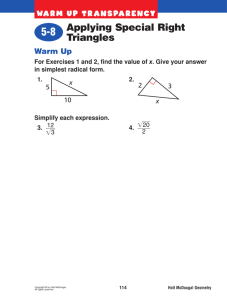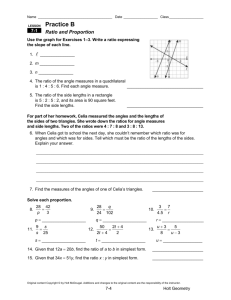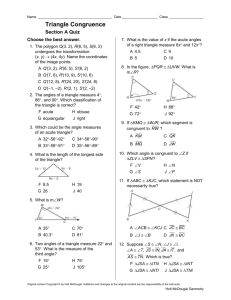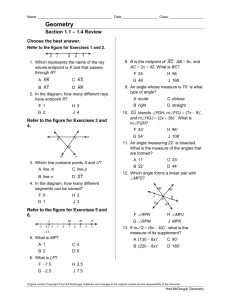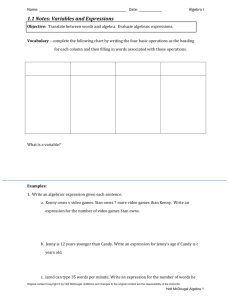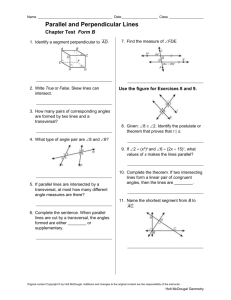Learning
advertisement
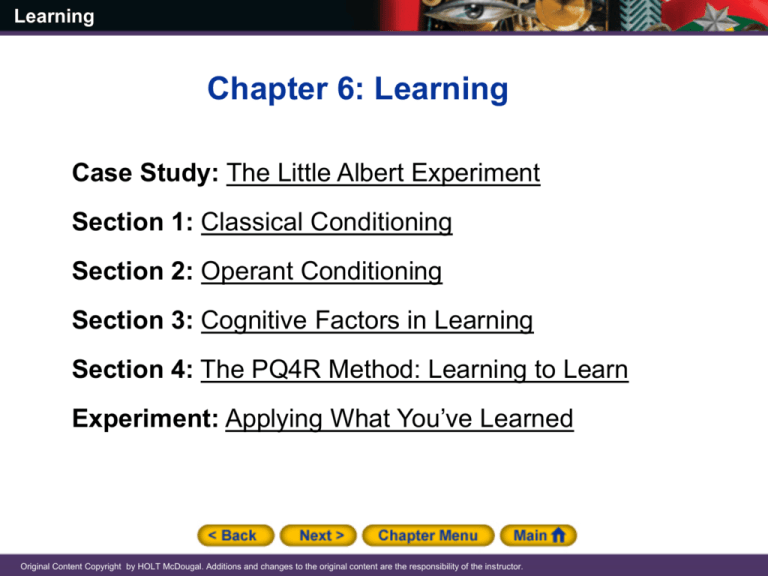
Learning Chapter 6: Learning Case Study: The Little Albert Experiment Section 1: Classical Conditioning Section 2: Operant Conditioning Section 3: Cognitive Factors in Learning Section 4: The PQ4R Method: Learning to Learn Experiment: Applying What You’ve Learned Original Content Copyright by HOLT McDougal. Additions and changes to the original content are the responsibility of the instructor. Learning Case Study: The Little Albert Experiment The Little Albert experiment showed that emotional reactions such as fear can be taught through classical conditioning. The Experiment The Results • Eleven-month-old Albert was conditioned to fear a white rat rather than be amused by it. • After they paired the rat with loud noises, Albert showed a fear of the rat even when there was no noise. • Psychologists achieved this by pairing the rat with something that Albert would find instinctively frightening. • By today’s standards, the experiment was unethical. • Albert’s fear spread to similar objects. Original Content Copyright by HOLT McDougal. Additions and changes to the original content are the responsibility of the instructor. Learning What do you think? • How did Watson and Rayner condition Little Albert to fear white rats? • Do you think you have learned to fear or enjoy certain things because of conditioning or association? Explain. Original Content Copyright by HOLT McDougal. Additions and changes to the original content are the responsibility of the instructor. Learning Original Content Copyright by HOLT McDougal. Additions and changes to the original content are the responsibility of the instructor. Learning Original Content Copyright by HOLT McDougal. Additions and changes to the original content are the responsibility of the instructor. Learning Section 1 at a Glance Classical Conditioning • Russian psychologist Ivan Pavlov pioneered research into a form of learning known as classical conditioning. In classical conditioning, one stimulus causes a response that is usually caused by another stimulus. • Classical conditioning can help people adapt to the environment and can help eliminate troubling fears or other behaviors. Original Content Copyright by HOLT McDougal. Additions and changes to the original content are the responsibility of the instructor. Learning Classical Conditioning Main Idea Classical conditioning is a form of learning that involves the use of a stimulus to generate a specific response. Reading Focus • What are the basic principles of classical conditioning? • How might classical conditioning help people or animals adapt to the environment? • What are some applications of classical conditioning? Original Content Copyright by HOLT McDougal. Additions and changes to the original content are the responsibility of the instructor. Learning Why do people have an immediate, physical response to a picture of pizza? Original Content Copyright by HOLT McDougal. Additions and changes to the original content are the responsibility of the instructor. Learning Principles of Classical Conditioning • Conditioning is a type of learning that involves stimulus-response connections. • Classical conditioning is a simple form of learning in which one stimulus calls forth the response that is usually called forth by another stimulus. Pavlov’s Dogs Stimulus and Response • Russian physiologist Ivan Pavlov used dogs in his studies of classical conditioning. • Unconditioned stimulus: a stimulus that causes a response that is automatic, not learned • He trained the dogs to associate the sound of a bell with food. • Unconditioned response: caused by an unconditioned stimulus • They learned that the sound of the bell meant food was coming. • Conditioned response: a learned response to a neutral stimulus • Conditioned stimulus: a previously neutral stimulus that causes a conditioned response Original Content Copyright by HOLT McDougal. Additions and changes to the original content are the responsibility of the instructor. Learning Original Content Copyright by HOLT McDougal. Additions and changes to the original content are the responsibility of the instructor. Learning Original Content Copyright by HOLT McDougal. Additions and changes to the original content are the responsibility of the instructor. Learning Reading Check Summarize How does classical conditioning occur? Answer: One stimulus calls forth the response that is usually called forth by another stimulus. Original Content Copyright by HOLT McDougal. Additions and changes to the original content are the responsibility of the instructor. Learning Adapting to the Environment Taste Aversions Extinction • Taste aversion: learned response to a particular food • Extinction: Disappearance of conditioned response when unconditioned stimulus no longer follows conditioned stimulus • One-trial learning Spontaneous Recovery • Spontaneous recovery: Reappearance of an extinguished conditioned response after some time has passed Generalization and Discrimination • Generalization: The tendency to respond in the same way to stimuli that have similar characteristics • Discrimination: The act of responding differently to stimuli that are not similar to each other Original Content Copyright by HOLT McDougal. Additions and changes to the original content are the responsibility of the instructor. Learning Reading Check Describe Give three examples of ways that classical conditioning can help people adapt to their environment. Answer: Students should cite examples of taste aversion, extinction, spontaneous recovery, generalization, or discrimination. Original Content Copyright by HOLT McDougal. Additions and changes to the original content are the responsibility of the instructor. Learning Applications of Classical Conditioning Flooding and Systematic Desensitization • In flooding, a person is exposed to the harmless stimulus until fear responses to that stimulus are extinguished. Counterconditioning • In counterconditioning, a pleasant stimulus is paired repeatedly with a fearful one, counteracting the fear. • With systematic desensitization, people learn relaxation techniques and then, while they are relaxed, they are gradually exposed to the stimulus they fear. Original Content Copyright by HOLT McDougal. Additions and changes to the original content are the responsibility of the instructor. Learning Original Content Copyright by HOLT McDougal. Additions and changes to the original content are the responsibility of the instructor. Learning Reading Check Identify What are three applications of classical conditioning? Answer: flooding, systematic desensitization, counterconditioning Original Content Copyright by HOLT McDougal. Additions and changes to the original content are the responsibility of the instructor. Learning Section 2 at a Glance Operant Conditioning • Psychologist B.F. Skinner helped pioneer research into a form of learning known as operant conditioning, in which individuals learn from the consequences of their actions. • Operant conditioning depends on the use of reinforcements and a schedule to execute them. • The principles of operant conditioning can be applied to help people or animals learn to combine a series of simple steps or actions to form complex behaviors. Original Content Copyright by HOLT McDougal. Additions and changes to the original content are the responsibility of the instructor. Learning Operant Conditioning Main Idea Operant conditioning occurs when people or animals have learned to respond to a certain situation. Reading Focus • How are operant conditioning and reinforcement related? • What are the main types of reinforcers? • How do rewards and punishments shape learning? • How do schedules of reinforcement influence learning? • What are some applications of operant conditioning? Original Content Copyright by HOLT McDougal. Additions and changes to the original content are the responsibility of the instructor. Learning Operant Conditioning and Reinforcement • In operant conditioning, people and animals learn to do certain things—and not to do others—because of the results of what they do. • They learn from the consequences of their actions. • In operant conditioning, voluntary responses are conditioned. • B.F. Skinner studied operant conditioning by using the “Skinner box.” • His experiment demonstrated reinforcement, or the process by which a stimulus (food) increases the chances that a preceding behavior (a rat pressing a lever) will occur again. • Knowledge of results is often all the reinforcement that people need to learn new skills. • Reinforcers always cause the behavior to occur again 1 Original Content Copyright by HOLT McDougal. Additions and changes to the original content are the responsibility of the instructor. Learning 2 Original Content Copyright by HOLT McDougal. Additions and changes to the original content are the responsibility of the instructor. Learning Question: Describe How does reinforcement result in operant conditioning? Answer: In operant conditioning, people and animals learn to do certain things because of the results of what they do. Reinforcement increases the chances that such behavior will occur again. 3 Original Content Copyright by HOLT McDougal. Additions and changes to the original content are the responsibility of the instructor. Learning Types of Reinforcers Primary and Secondary Reinforcers Positive and NegativeReinforcers • Primary reinforcers are reinforcers that function due to the biological makeup of an organism. • Positive reinforcers increase the frequency of a behavior. • Secondary reinforcers are learned by being paired with primary reinforcers. • Money is a secondary reinforcer because we have learned that it may be exchanged for primary reinforcers like food and shelter. • In positive reinforcement, a person receives something he or she wants following the behavior. • Negative reinforcers increase the frequency of a behavior when they are removed. • In negative reinforcement, a behavior is reinforced because something unwanted stops happening or is removed following the behavior. 4 Original Content Copyright by HOLT McDougal. Additions and changes to the original content are the responsibility of the instructor. Learning Movie is added as reward Buzzing sound is removed Different than negative reinforcement b/c it decreases behavior (reinforcers always Increase behaviors) 5 Original Content Copyright by HOLT McDougal. Additions and changes to the original content are the responsibility of the instructor. Learning Concept Check Summarize Describe the four main types of reinforcers. Answer: 1. Primary reinforcers are those that people and animals do not need to be taught to value, such as food and water. 2. Secondary reinforcers, like money, must be learned. 3. Positive reinforcers, such as food and fun, increase the frequency of the behavior they follow when they are applied. 4. Negative reinforcers increase the frequency of the behavior that follows when they are removed. They are unpleasant, and include discomfort and fear. (something unwanted stops happening after the behavior) 6 Original Content Copyright by HOLT McDougal. Additions and changes to the original content are the responsibility of the instructor. Learning Rewards and Punishments Rewards Punishments • Like positive reinforcement, rewards help encourage learning. • Punishments are quite different from negative reinforcers. • Some psychologists, however, prefer positive reinforcement because the concept of reinforcement can be explained without trying to guess what an organism will find rewarding. • Punishments are unwanted events that decrease the frequency of the behavior they follow. • Punishments tend to work only when they are guaranteed. • Most psychologists believe it is preferable to reward children for desirable behavior than punish them for unwanted behavior. 7 Original Content Copyright by HOLT McDougal. Additions and changes to the original content are the responsibility of the instructor. Learning 8 Original Content Copyright by HOLT McDougal. Additions and changes to the original content are the responsibility of the instructor. Learning Schedules of Reinforcement • The effectiveness of a reinforcement depends on the schedule of reinforcement—when and how often the reinforcement occurs. Continuous and Partial Reinforcement Interval Schedules • Continuous reinforcement is the reinforcement of a behavior every time the behavior occurs. • Fixed-interval schedule: a fixed amount of time must elapse between reinforcements (paycheck every Fri) • Continuous reinforcement is not always practical or possible. • The alternative is partial reinforcement, which means a behavior is not reinforced every time the behavior occurs. • Variable-interval schedule: varying amounts of time go by between reinforcements (boss “drops in”) schedules of reinforcement Original Content Copyright by HOLT McDougal. Additions and changes to the original content are the responsibility of the instructor. Learning Original Content Copyright by HOLT McDougal. Additions and changes to the original content are the responsibility of the instructor. Learning Ratio Schedule • Fixed-ratio schedule: reinforcement occurs after a fixed number of responses (food pellet to rat after every 5 tries) • Variable-ratio schedule: reinforcement occurs after a varying number of responses Extinction in Operant Conditioning • In operant conditioning, extinction results from repeated performances of the response without reinforcement. (food pellets to a rat after one bar press, again after four bar presses, and a third pellet after two bar presses) schedules of reinforcement handout Original Content Copyright by HOLT McDougal. Additions and changes to the original content are the responsibility of the instructor. Learning Concept Check Infer Why are both variable-interval schedules and variable-ratio schedules successful? (behaviors learned through partial reinforcement tend to last longer after they are no longer being reinforced than behaviors learned through continuous reinforcement) (tend to maintain that behavior only as long as the reinforcer is there) Answer: because timing is unpredictable; reinforcement can come at any time (think pop quizzes) Original Content Copyright by HOLT McDougal. Additions and changes to the original content are the responsibility of the instructor. Learning Three Ways Operant Conditioning Can Be Applied Shaping and Chaining Programmed Learning • Shaping is a way of teaching complex behaviors in which one first reinforces small steps in the total activity. • Programmed learning is based on shaping and chaining. • Chaining is combining the steps of a sequence to progress toward a final action. • Chaining can be forward or backward. • Chaining can be used to teach complex behavior patterns to people and animals. • Developed by B.F. Skinner, it assumes that any task can be broken down into small steps. • Programmed learning does not involve punishments. • Instead, it reinforces correct responses. • Computer “frames” where you can’t move on until you’ve mastered a concept Original Content Copyright by HOLT McDougal. Additions and changes to the original content are the responsibility of the instructor. Learning Concept Check Identify Supporting Details What are three examples of applications of operant conditioning? Answer: shaping, chaining, programmed learning Original Content Copyright by HOLT McDougal. Additions and changes to the original content are the responsibility of the instructor. Learning Section 3 at a Glance Cognitive Factors in Learning • Cognitive psychologists focus on the mental aspects of learning and are interested in what people or animals know, not just what they do. • Cognitive learning is based on the idea that people and animals can learn by thinking or by watching others. • Some techniques for behavioral modification are based on the ideas of operant conditioning and cognitive factors. Original Content Copyright by HOLT McDougal. Additions and changes to the original content are the responsibility of the instructor. Learning Cognitive Factors in Learning Main Idea Cognitive learning focuses on the mental aspects of learning, such as obtaining, processing, and organizing information. Cognitive psychologists are interested not only in what people do, but also what they know. Questions to Consider • What is latent learning? • In what situations does observational learning take place? • What learning principles are involved in behavior modification? Original Content Copyright by HOLT McDougal. Additions and changes to the original content are the responsibility of the instructor. Learning What do tamales have to do with Christmas? Original Content Copyright by HOLT McDougal. Additions and changes to the original content are the responsibility of the instructor. Learning Latent Learning • One kind of cognitive learning is latent learning, which is learning that remains hidden until it is needed. • Most psychologists believe that much learning takes place without reinforcement. Cognitive Maps Mental Pictures Original Content Copyright by HOLT McDougal. Additions and changes to the original content are the responsibility of the instructor. Learning Reading Check Recall When is latent learning revealed? Answer: Latent learning is revealed when it is needed. (We remembered that we knew where the corner of Tonnele and Van Reypen and 4th was) Original Content Copyright by HOLT McDougal. Additions and changes to the original content are the responsibility of the instructor. Learning Observational Learning • Observational learning is knowledge and skills acquired by observing and imitating others. Modeling The Effects of Media Violence • Modeling is basically a kind of imitation. • Television is a major source of informal observational learning. • Vicarious reinforcement is the ability to learn from the experiences of another. • Most health professionals agree that media violence contributes to aggression. • Observational learning and modeling account for much human learning. (think norms) Original Content Copyright by HOLT McDougal. Additions and changes to the original content are the responsibility of the instructor. Learning Click on the image to play the Interactive. Original Content Copyright by HOLT McDougal. Additions and changes to the original content are the responsibility of the instructor. Learning Concept Check Describe What are three examples of observational learning? Answer: child learning to speak, eat, and play from parents Original Content Copyright by HOLT McDougal. Additions and changes to the original content are the responsibility of the instructor. Learning Original Content Copyright by HOLT McDougal. Additions and changes to the original content are the responsibility of the instructor. Learning Behavior Modification Classroom Discipline • Teachers are taught to pay attention to students when they are behaving appropriately and to ignore misbehavior that is not harmful to themselves or others. Token Economics • People are “paid” to act correctly by earning rewards that can be cashed in for treats, merchandise, or privileges. Original Content Copyright by HOLT McDougal. Additions and changes to the original content are the responsibility of the instructor. Learning Personal Contracts • A personal contract is a personal behavior modification technique. • It works by first identifying a behavior you want to change, setting a goal for a new behavior, and creating a system of rewards or punishments that encourage the new behavior. “I think I’ll change….” Original Content Copyright by HOLT McDougal. Additions and changes to the original content are the responsibility of the instructor. Learning Concept Check Explain How are learning principles used to modify behavior? Answer: classroom discipline—misbehaving students may be separated from the rest of the class; token economies—people are “paid” to act correctly by earning rewards; personal contracts—people can create a system of rewards or punishments to alter their behavior Original Content Copyright by HOLT McDougal. Additions and changes to the original content are the responsibility of the instructor. Learning Psychology in Today’s World (page 177) Pathways to Rewards Pathways to Rewards is a program that seeks to help improve the lives of public housing residents in Chicago. The program uses the principles of token economies and has proved to be highly successful in helping people modify their behavior through a system of individual goals and rewards. • The Pathways to Rewards program is for residents of Henry Horner Homes in Chicago. • Residents set monthly goals and establish the steps needed to reach them. • Adults and children may participate in the program. • Participants earn points for meeting their goals. • The points can be redeemed for rewards such as merchandise, billpaying assistance, and health club membership. • At the end of 2007, 58 percent of eligible residents had enrolled in the program. Original Content Copyright by HOLT McDougal. Additions and changes to the original content are the responsibility of the instructor. Learning Original Content Copyright by HOLT McDougal. Additions and changes to the original content are the responsibility of the instructor. Learning Thinking Critically • Why do you think this program is successful? • Some people have criticized the Pathways to Rewards program as being bribes for good behavior. How do you view this criticism? Original Content Copyright by HOLT McDougal. Additions and changes to the original content are the responsibility of the instructor. Learning Section 4 at a Glance The PQ4R Method: Learning to Learn • The PQ4R method is a study method based on the work of educational psychologist Francis P. Robinson. Robinson believed that students will learn more when they take an active approach to learning. • The PQ4R method includes these six steps: preview, question, read, reflect, recite, and review. Original Content Copyright by HOLT McDougal. Additions and changes to the original content are the responsibility of the instructor. Learning Page 178 Have educational psychologists created an easy way to study and learn new material? Original Content Copyright by HOLT McDougal. Additions and changes to the original content are the responsibility of the instructor. Learning Preview and Question Preview • Previewing a textbook means getting a general picture of the material before you start to read. • Many textbooks are designed to encourage previewing. • Previewing helps form a cognitive map of a chapter. Question • You can create learning goals by writing questions about the chapter after you preview it. • One way to write questions is to read the headings or the first sentence of each paragraph and write a question about it. Original Content Copyright by HOLT McDougal. Additions and changes to the original content are the responsibility of the instructor. Learning Original Content Copyright by HOLT McDougal. Additions and changes to the original content are the responsibility of the instructor. Learning Concept Check Compare How are the steps of previewing and questioning similar? Answer: Both take place before a person starts reading. Original Content Copyright by HOLT McDougal. Additions and changes to the original content are the responsibility of the instructor. Learning Read, Reflect, Recite, and Review Read Reflect • Read the chapter with the goal of answering the questions you wrote. • Relate new information to old information. • As you read, jot down a few key words that will remind you of the answer. • Relate new information to events in your own life or to people you know. Recite Review • After you have answered your questions, recite the answers out loud or silently to yourself. • Learning that occurs regularly and is distributed over time is distributed learning. • You can recite alone or with a study group. Both are effective. • Learning that occurs all at one time is massed learning, or cramming. Original Content Copyright by HOLT McDougal. Additions and changes to the original content are the responsibility of the instructor. Learning Distributed Learning: studying something regularly so the learning is distributed over a number of days Original Content Copyright by HOLT McDougal. Additions and changes to the original content are the responsibility of the instructor. Learning Massed Learning: trying to learn everything at once Original Content Copyright by HOLT McDougal. Additions and changes to the original content are the responsibility of the instructor.

